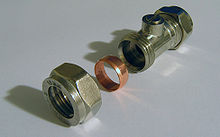- Compression fitting
-
Compression fittings are used in plumbing and electrical conduit systems to join two tubes or thin-walled pipes together. In instances where two pipes made of dissimilar materials are to be joined (most commonly PVC and copper), the fittings will also be made of one or more compatible materials appropriate for the connection. Compression fittings for attaching tubing (piping) commonly have ferrules (or olives in the UK) in them.
Compression fittings are also used extensively for hot and cold water faucets (taps) and toilet stop valves; compression fittings are well suited to this application, as these valves are usually located in confined spaces where copper pipe would be difficult to solder without creating a fire hazard.
Compression fittings are the industry standard for chemical, oil and gas, R&D, Bio-tech, and the semiconductor industry.[citation needed] They are used due to their ability to provide leak tight seals. These fittings can be remade.
Contents
How they work
The compression fitting is composed of an outer compression nut and an inner compression ring; or ferrule that is usually made of brass or copper. Ferrules vary in shape and material but are most commonly in the shape of a ring with beveled edges and they are most commonly made out of brass or according to the pipe material. To work properly, the ferrule must be oriented correctly; typically the ferrule is fitted such that the longest sloping face of the ferrule faces away from the nut.
When the nut is tightened, the ferrule is compressed between the nut and the receiving fitting; the ends of the ferrule are clamped around the pipe, and the middle of the ferrule bows away from the pipe, making the ferrule effectively thicker. The result is that the ferrule seals the space between the pipe, nut, and receiving fitting, thereby forming a tight joint.
Thread sealants such as joint compound (pipe "dope") or thread seal tape (PTFE tape, or Teflon tape) are inappropriate for use on compression fitting threads; while such sealants protect against leaks in normal threaded connections, they serve little purpose in compression fittings and may actually serve to weaken them.[citation needed] The compression of the ferrule (rather than the sealing of the threads) is the means of sealing the joint in a compression fitting, and extraneous sealants frequently interfere with this condition; for instance, thread seal tape can provide a means for a gap to form between the ferrule and the nut.
It is important to the integrity of a compression fitting that excessive force be avoided when tightening the nut. If the nut is overtightened, the ferrule frequently deforms improperly causing the joint to fail. Indeed, overtightening is the most common cause of leaks in compression fittings. A good rule of thumb is to tighten the nut first by hand until it is too difficult to continue and then tighten the nut a half-turn more with the aid of a wrench; the actual amount varies with the size of the fitting, as a larger one requires less tightening. The fitting is then tested: If slight weeping is observed, the fitting is slowly tightened until the weeping stops.
The most important component in a compression fitting is the ferrule itself, which is extremely prone to damage. Care should be used when installing it (although if it becomes defective, it is easy to install a replacement). Master plumbers have been known in some instances to replicate the sealing action of the ferrule by using an artfully "woven" piece of thread seal tape. This is usually attempted as a temporary solution to prevent a leak until new parts can be procured.
Types of fittings
There are two common types of compression fitting, standard (British, type-A/non-manipulative) and flare fittings (British, type-B/manipulative). Standard fittings require no modifications to the tubing. Flare fittings require modification of the tubing with a special tool. Standard fittings are generally used for water and compressed air connections, while flare fittings are used for gas and high pressure lines.
A standard fitting can be installed using an ordinary wrench to tighten the surrounding nut. To remove it, a specialized puller is often used to slide the nut and ferrule off the tube.
Advantages
Compression fittings are popular because they do not require soldering, so they are comparatively quick and easy to use. They require no special tools or skills to operate. They work at higher pressures and with toxic gases. Compression fittings are especially useful in installations that may require occasional disassembly or partial removal for maintenance etc, since these joints can be broken and remade without affecting the integrity of the joint. They are also used in situations where a heat source, in particular a soldering torch, is prohibited.
Disadvantages
Compression fittings are not as robust as soldered fittings. They should be used in applications where the fitting will not be disturbed and not subjected to flexing or bending. A soldered joint is highly tolerant of flexing and bending (such as when pipes knock or shake from sudden pressure changes). Compression fittings are much more sensitive to these type of dynamic stresses. They are also bulkier, and may be considered less aesthetically pleasing than a neatly soldered joint.
See also
Notes and references
External links
Categories:
Wikimedia Foundation. 2010.

